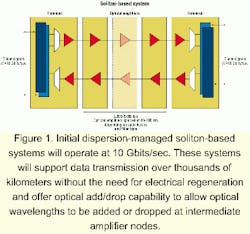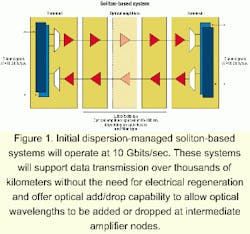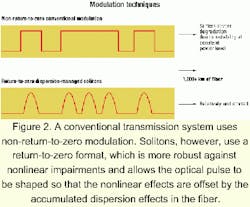Coming soon... dispersion-managed soliton networks
A new transmission technology that keeps its shape over longer distances is expected to leave the lab and reach commercial systems this year.
BY JEFF STERN, Marconi Solstis
You may be hearing some talk about an emerging technology that holds tremendous promise for service providers jockeying for leadership in today's dynamic, cutthroat marketplace. Dispersion-managed solitons, also known as return-to-zero (RZ) modulation, can dramatically increase the transmission speeds of optical networks to rates in excess of 1 Tbit/sec (1,000 Gbits/sec) over thousands of kilometers, using WDM techniques.
For service providers seeking to transmit data further, faster, and wider; dispersion-managed soliton-based networks may be the answer. Not only will this technology allow service providers to significantly lower transmission and bandwidth costs, it will make networks easier to provision and manage and can incorporate add/drop functionality that will offer the flexibility to tailor bandwidth capacity to demand at intermediate nodes along an ultra-long-haul route.
Although the dispersion-managed soliton is a relatively new technology, its origins date back to the 19th century, when Scottish engineer John Scott Russell discovered solitary waves while conducting experiments to determine the most efficient design for canal boats. But not until the mid-1960s, when digital computers were used to study nonlinear wave propagation, were Russell's discoveries truly appreciated.
The physical properties of the soliton wave, which is an optical pulse that doesn't break up or spread out over distances, make it an ideal technology for optical-fiber communications networks. A soliton is designed to change shape in a periodic, controlled manner so it arrives at its destination unaltered. Therefore, dispersion-managed soliton-based infrastructures reduce the need to regenerate channels, making these networks a cost-effective step up from traditional fiber networks.
With conventional optical transmission, optical amplifiers are used to boost the optical signals, typically every 60 to 100 km. Every few hundred kilometers, however, it is necessary to fully regenerate the optical signal to remove the effects of noise and other transmission impairments. That involves a lot of very expensive equipment to turn the wavelengths of light back into an electrical signal so that each can be individually processed. In contrast, solitons change the way in which data is encoded in the optical network, allowing much greater distances to be achieved before regeneration is necessary, which in turn enables service providers to slash their transmission costs.The tremendous competitive challenges faced today by service providers mean that the market is certainly ripe for the benefits of this revolutionary technology. Commercial deployments are expected to get underway this year.
In the meantime, the technology continues to be developed, refined, and tested in trials by several leading service providers. To date, world-record data-transmission speeds have been demonstrated during laboratory trials. For example, using this technology, a standard optical fiber carried 10 Gbits/sec of data across a distance of 16,000 km, and 40 Gbits/sec of information was transmitted for more than 1,000 km.
For service providers contemplating a move from a conventional fiber network to a dispersion-managed soliton-based system, the transition is quick, easy, and virtually transparent. The network architecture will look much the same as it does today. The only change is a drastic reduction in the number of regeneration or terminal sites required. Figure 1 illustrates the type of system anticipated for deployment this year. Initial dispersion-managed soliton systems will operate at 10 Gbits/sec, with later products moving to 40-Gbit/sec operation. Transmission systems carrying up to 160 wavelengths are planned. These systems will support data transmission over thousands of kilometers without the need for electrical regeneration and offer optical add/drop capability to allow optical wavelengths to be added or dropped at intermediate amplifier nodes.
The ability to turn up capacity quickly on a route to meet new demands from customers will be a major benefit of these dispersion-managed soliton systems for service providers. Currently, if new capacity is needed on a route thousands of kilometers long, the service provider must intervene at multiple regenerator sites along the route to install or activate new equipment. Dispersion-managed soliton technology will allow service providers to remotely activate wavelengths on an end-to-end basis using network-management systems, which will dramatically shorten provisioning times.On a technical level, the main differences between the soliton equipment and conventional DWDM systems is a new type of transponder to generate the soliton pulses and improved optical amplifiers to handle the higher optical signal levels. (A transponder converts a signal from electrical to optical and back to electrical in the fiber.) Soliton products will also feature the use of Raman amplification as well as conventional erbium-based optical-amplifier technology.
Before deciding whether to implement a dispersion-managed soliton network, it's worthwhile to examine the nuts and bolts of an optical-fiber transmission system, its strengths and limitations, to understand the reasons for these new soliton developments.
The simplest form of optical transmission is a point-to-point optical-fiber cable with a transmitter at one end and a receiver at the other. A laser light shone down the fiber carries data along the length of the fiber. The ultimate goal is for the data to reach the end of the line, identical to how it began. Optical-fiber networks are subject to a number of impairments that affect how far data can travel down the fiber, however. The principle impairments are signal loss, chromatic dispersion, and nonlinearity.
- Loss refers to the reduction in power that takes place as light travels along the fiber. As a result, long-distance cables require optical amplifiers at periodic intervals to restore the strength of the signal. But noise on the optical signal increases with the number of amplifier spans, eventually limiting overall system range before electrical regeneration is necessary.
- Chromatic dispersion arises because light travels down the fiber at different speeds depending on the wavelength. Since all optical signals consist of a finite spread of wavelengths, dispersion leads to optical pulse broadening over a long distance, thereby limiting bandwidth. This effect is well known in conventional optical transmission systems and can be countered by the use of dispersion compensation modules (DCMs) at optical-amplifier and regenerator nodes.
- Nonlinear effects, which are only now becoming important as fiber-optic systems reach for still greater performance, arise due to the very high light-intensity levels needed to go very long distances. The intensity of the light actually changes the refractive index of the fiber causing a phase modulation of the light as it is transmitted. That leads to a change in optical frequency along the pulse of light, which in turn leads to pulse broadening, limiting system bandwidth.
The dilemma for the ultra-long-system designer therefore is whether to raise the optical signal power to overcome noise effects or reduce it to prevent nonlinear effects. That is where solitons offer an advantage. It is possible to balance the effects of dispersion and nonlinearity to create soliton pulses that transmit through the fiber with near-ideal properties, allowing much higher optical power levels to be used than would otherwise be the case.
A conventional system uses non-return-to-zero modulation (see Figure 2). Solitons, however, use a return-to-zero format which is more robust to nonlinear impairments and allows the optical pulse to be shaped so that the nonlinear effects are offset by the accumulated dispersion effects in the fiber. The dispersion characteristics of the route still have to be correctly managed as part of the overall system design, hence the term "dispersion-managed solitons." Although, a different set of design rules is used, dispersion management in soliton networks is done in a similar manner to conventional long-haul, high-bit-rate DWDM systems-by using passive compensation elements (DCMs) at the optical-amplifier nodes.
Some skeptics argue that when it comes to ultra-long-haul transmission, service providers may have to sacrifice bandwidth capacity for distance. However, dispersion-managed soliton vendors are working to refine the technology to achieve transmission distances of several thousand kilometers without sacrificing capacity.
Once dispersion-managed soliton technology is introduced in the marketplace, it is anticipated that the technology will continue to evolve, lowering its cost. Lower cost will facilitate its use throughout service providers' networks, not just in ultra-long-haul backbones.
Dispersion-managed soliton-based networks are expected to set new standards in optics transmission. This new transmission technology will put service providers on the fast track to success by equipping their networks with systems that can beat a bandwidth crunch that is expected to continue in the foreseeable future.
Jeff Stern is the product strategy director at Marconi Solstis, based in Stratford-on-Avon, UK. He can be reached via e-mail at [email protected].


